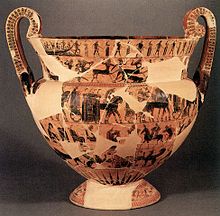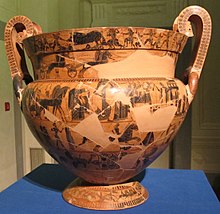User:Garcia091995/sandbox
The François Vase is a large

Descriptions of Decorations
The uppermost frieze, on the neck of the krater, depicts on side A
The second band on side A shows the chariot race which is part of the funeral games for

The third frieze on both sides, the highest and also most prominent one because of its location on the top of the body vessel, depicts the procession of the gods to the wedding of Peleus and Thetis. Because of its large number of figures, the procession is a suitable topic to decorate the long band. The end of the procession shows Peleus between an altar and the house where Thetis can be seen sitting inside. He is greeting his teacher, the centaur Chiron, who is heading the procession together with the divine messenger Iris
The fourth frieze on side A depicts the ambush of Troilus by Achilles. Side B shows the return of Hephaestus to Olympus; sitting on a mule, he is led to the Olympian gods by Dionysus, followed by a group of silens and nymphs.
The fifth frieze shows sphinxes and griffins flanking lotus blossom and palmettes ornaments and panthers and lions attacking bulls, a boar, and a deer.
On the foot of the vessel, there is on both sides a depiction of the battle between the Pygmies and the cranes.
The handles are decorated as well, showing on their outer sides the so-called
Interpretation of the Decorations
The wedding of
The various scenes on the pot seem to be held together by two sorts of association. On one hand there are a set of scenes which trace the story of the house of Peleus from his participation in the hunt for the
On the other hand there are scenes which offer parallels to these episodes: the processional return of the god Hephaestus to Olympus (second frieze up) parallels the celebration of Peleus' wedding to Thetis. The battle of lapiths and centaurs and the liberation of the Athenians from the Minotaur parallel the deliverance from the Calydonian boar, and link Peleus' exploits to those of the Athenian hero Theseus. Such typological parallels are one of the means by which poets too from Homer on have enriched their narratives
Kleitas and Ergotimos

During the Archaic Period, Kleitas (Cleitas) (c. 580- c. 550 BCE) was a well known potter and painter. He was the painter of one of the greatest vases ever made from Greek art, the Francois Vase. Kleitas signature has been found on five vases, four of them are signed by Kleitias as the painter and Ergotimos as the potter. Other collaborations of the two include two cups and some cup fragments, from which their signatures were lost. Other vases have been attributed to Kleitas on the basis of style. Kleitas was detailed in his drawings especially with animal and human anatomy and when showing textiles making him a unique artist of his time. He engages his viewers by bringing variety to every image allowing the viewer to discover each figure differently each time. He pioneers the use of paired figures: particularly in the topmost friezes on each side, the boar hunt. The boat returning from Crete, he makes repeated use of figures who are side by side and engaged in similar actions so that one sees only part of the figure behind, which becomes a sort of shadow of the figure in the front. Other collaborations of the two include two cups and some cup fragments, from which their signatures were lost. Other vases have been attributed to Kleitas on the basis of style.[11]
References
- ^ Osborne, Robin. Archaic and Classical Greek Art. p. 93.
- ^ Iozzo, Mario. The Francois Vase.
- ^ "Making"/"poiein" and "painting"/"graphein" as two different activities in pottery are distinguished in painted signatures on ancient Greek pots as early as the middle of the 7th century BCE; while the first extant signature stating that someone "made" a pot comes from the late 8th century BCE, we find the earliest reference to its "painting" in an inscription on a pot dating from the middle of the 7th century BCE (see R. Wachter, Non-Attic Greek Vase Inscriptions, Oxford 2001, EUC 1 and IOI 5, respectively).
- ^ "Francois Vase". Ancient History Encyclopedia. Retrieved 2017-10-01.
- ^ Cartwright, Mark. Francois Vase. Ancient History Encyclopedia.
- ^ So-called because it depicts the culmination of the procession shown on the vessel’s main frieze, the top band on the body, which is also the highest of all.
- ^ For the exact nature of the relationship between Achilles and Patroclus, see the article on Achilles and Patroclus.
- ^ Osborne, Robin. Archaic and Classical Greek Art.
- ^ Osborne, Robin. Archaic and Classical Greek Art.
- ^ Barringer, Judith. Hunters and Hunting on the Francois Vase.
- ^ "Ergotimos and Kleitas".
